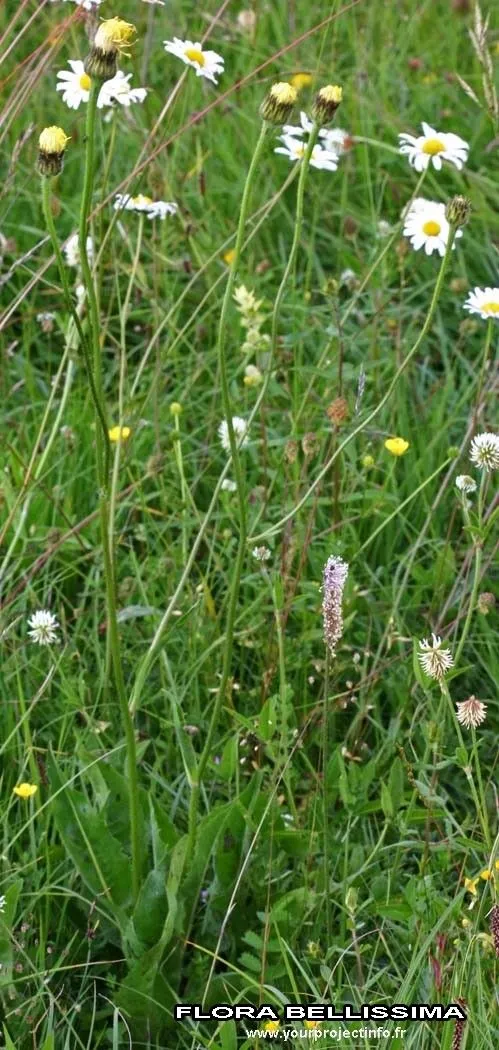
Author: L.
Bibliography: Sp. Pl.: 810 (1753)
Year: 1753
Status: accepted
Rank: species
Genus: Hypochaeris
Vegetable: False
Observations: Europe to Siberia and Xinjiang
Spotted cat’s-ear, known scientifically as Hypochaeris maculata, is a fascinating plant that has captivated botanists and plant enthusiasts alike since it was first described in Species Plantarum in 1753 by the esteemed botanist Carl Linnaeus. This delightful member of the Asteraceae family boasts a rich geographical distribution, thriving across diverse regions extending from Europe all the way to Siberia and into Xinjiang.
The plant is easily recognizable by its striking floral features, which often include delicate, daisy-like flowers. These blooms typically display a vibrant array of hues, bringing a splash of color to the landscapes they adorn. As its common name suggests, the leaves of the spotted cat’s-ear are distinguished by unique spot patterns, adding an extra layer of visual interest to this already charming species.
Spotted cat’s-ear is not just a feast for the eyes but also plays a significant role in the ecosystems where it is native. It is well-adapted to a variety of environmental conditions, allowing it to flourish in a wide range of habitats. From the lush gardens of Europe to the more temperate zones of Siberia and even the diverse climates of Xinjiang, Hypochaeris maculata demonstrates an impressive adaptability and resilience.
Botanical studies often highlight the plant’s robust nature and its capacity to grow in both wild and cultivated settings. Given its wide range of habitats, Hypochaeris maculata can provide valuable insights into the ecological dynamics of different regions. It can serve as a bioindicator in environmental science due to its sensitivity to changes in habitat conditions, making it an important species for monitoring ecosystem health.
In summary, the spotted cat’s-ear (Hypochaeris maculata) is a remarkable plant noted not only for its aesthetic appeal but also for its broad distribution and ecological significance. This species continues to be a subject of interest in botanical research and environmental studies, thanks to its unique characteristics and wide-ranging adaptability.
En: Spotted Cat’s-ear
Sq: Hipoker me njolla
Ar: أذن القطة المبقعة
Be: Жаўтакруг рабы
Bg: Петнист хипохерис
Ca: Hipoqueris maculada
Zh: 新疆猫儿菊
Hr: Pjegasti jastrebljak
Cs: Prasetník plamatý, Náholník plamatý
Da: Plettet Kongepen
Nl: Gevlekt biggenkruid, Gevlekt Biggekruid
Et: Veishein
Fi: Häränsilmä, Harjuhäränsilmä
Fr: Porcelle à feuilles tachées, Porcelle mâle, Porcelle tachetée, Porcelle tachée
De: Geflecktes Ferkelkraut, Geflechtes Ferkelkraut
It: Costolina macchiata
Lv: Plancumainā pelūde
Lt: Dėmėtoji džiugūnė
Se: Vuovssáfivli
No: Flekkgrisøyre, Frue-kaal
Pl: Prosienicznik plamisty
Ro: Буруянэ порчаскэ макулатэ
Sv: Slåtterfibbla
Cy: Melynydd brych, Melynydd Brychog
: Spotted cat’s-ear
Taken Jul 9, 2021 by k.dimitrov d (cc-by-sa)
Taken Jun 27, 2021 by Manuëlle (cc-by-sa)
Taken Jul 18, 2021 by André Hyvrier (cc-by-sa)
Taken Jul 18, 2021 by André Hyvrier (cc-by-sa)
Taken Oct 17, 2022 by Maurizio Guzzinati (cc-by-sa)
Taken Jan 1, 1800 by Tela Botanica − Thierry Pernot (cc-by-sa)
Taken May 8, 2016 by Tela Botanica − Genevieve BOTTI (cc-by-sa)
Taken Jul 23, 2019 by Mael Taupin (cc-by-sa)
Taken Aug 1, 2018 by Olivier Le Gall (cc-by-sa)
Taken Jul 9, 2021 by k.dimitrov d (cc-by-sa)
Taken Jan 1, 1800 by Tela Botanica − Thierry Pernot (cc-by-sa)
Taken Jan 1, 1800 by Tela Botanica − Thierry Pernot (cc-by-sa)
Taken Jul 9, 2012 by Tela Botanica − Hugues TINGUY (cc-by-sa)
Taken Jul 6, 2015 by Tela Botanica − Yoan MARTIN (cc-by-sa)
Taken Jul 9, 2012 by Tela Botanica − Hugues TINGUY (cc-by-sa)
Taken Jan 1, 1800 by Tela Botanica − Thierry Pernot (cc-by-sa)
Taken Jul 14, 2017 by Yoan MARTIN (cc-by-sa)
Taken Jul 6, 2015 by Tela Botanica − Yoan MARTIN (cc-by-sa)
Taken Jul 14, 2017 by Yoan MARTIN (cc-by-sa)
Taken Jul 14, 2017 by Yoan MARTIN (cc-by-sa)
Taken Jun 2, 2018 by Tela Botanica − Liliane ROUBAUDI (cc-by-sa)
Taken Jun 2, 2018 by Tela Botanica − Liliane ROUBAUDI (cc-by-sa)
Taken Jun 2, 2018 by Tela Botanica − Liliane ROUBAUDI (cc-by-sa)
Taken Jun 2, 2018 by Tela Botanica − Liliane ROUBAUDI (cc-by-sa)
Taken Jun 2, 2018 by Tela Botanica − Liliane ROUBAUDI (cc-by-sa)
Taken Jul 15, 1999 by Photoflora – Benoit BOCK (©)
Taken Jan 1, 1970 by Photoflora – L’Abbé COSTE (©)
Taken Jul 15, 2011 by Photoflora – Benoit BOCK (©)
© copyright of the Board of Trustees of the Royal Botanic Gardens, Kew.
© copyright of the Board of Trustees of the Royal Botanic Gardens, Kew.
Light: 7
Bloom months: [‘jun’]
Soil nutriments: 3
Family: Myrtaceae Author: (F.Muell.) K.D.Hill & L.A.S.Johnson Bibliography: Telopea 6: 402 (1995) Year: 1995 Status:…
Family: Rubiaceae Author: Pierre ex A.Froehner Bibliography: Notizbl. Bot. Gart. Berlin-Dahlem 1: 237 (1897) Year:…
Family: Sapindaceae Author: Koidz. Bibliography: J. Coll. Sci. Imp. Univ. Tokyo 32(1): 38 (1911) Year:…
Family: Asteraceae Author: A.Gray Bibliography: Pacif. Railr. Rep.: 107 (1857) Year: 1857 Status: accepted Rank:…
Family: Fabaceae Author: Medik. Bibliography: Vorles. Churpfälz. Phys.-Ökon. Ges. 2: 398 (1787) Year: 1787 Status:…
Family: Aspleniaceae Author: (Cav.) Alston Bibliography: Bull. Misc. Inform. Kew 1932: 309 (1932) Year: 1932…